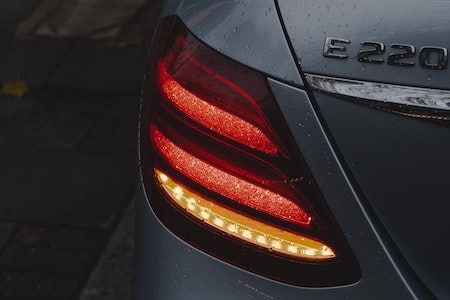LED lights are superior to incandescent in so many ways. They don’t get as hot, run more efficiently and last longer! So why aren’t they everywhere in a car especially in turn signals. For my car it’s such a pain to have to replace light bulbs because of all the trim and plastics removal just to get to the lights. So why use incandescent turn signals when most of the other lights in modern cars are LED?!
Turn signals designed for incandescent bulbs do not function with an LED bulb, so are not simply interchangeable. This along with the fact that the lifespan of incandescent turn signals is comparable to the LEDs in the tail and head lights is why car manufacturers choose not to upgrade the turn signal bulbs.
Despite this, most agree that LEDs look better and many car owners choose to upgrade their head lights, tail lights, and turn signals to LED. Although it is not a direct swap, it is possible and there are retrofit kits available and also a fairly simple DIY method that I will cover here!
If interested in an LED upgrade from incandescent, then this 5 minute read will aid in understanding how the turn signals operate and what must be done to use LED light bulbs as well as why car manufacturers have left them alone.

Incandescent Turn Signals
Turn signals remain incandescent by most car manufacturers because the bulb is on so infrequently that the life of the turn signal even with an incandescent bulb is comparable to the LEDs on the rest of the car.
The turn signal circuit must be redesigned and in many vehicles it has not been done so the turn signals remain incandescent. And because LEDs are more expensive, this is an avoidable expense that car manufacturers opt out of.
Even if they replaced the less appealing turn signal with a clean LED, the turn signals aren’t on for their promotional photo shoots and as long as the lights look good with the turn signals off, it does not present a real benefit to the car manufacturer.
We can all agree that LEDs are prettier, brighter, more efficient, and longer-lasting and that is why most of the cars exterior lights today are LED.
These reasons are why turn signals remain incandescent while the other light bulbs have been swapped to LED
The circuit design for incandescent bulbs does not work if LED bulbs are substituted so it is not a simple bulb substitution but can be done.
Let’s first look at how incandescent turn signals operate.
How the Turn Signal System Works
Incandescent turn signal relays rely on a precise increase in resistance from the bulb when it is turned on in order to flash.
The relay used for an incandescent turn signal circuit is a thermal relay that contains a coil, capacitor, and resistor and operates like a switch opening and closing the contacts. It relies on the current draw from the light bulb, to open and close repeatedly.
The flasher relay is what relies on the fluctuation of resistance from the current draw of the bulb and the repeated switching of the contacts opening and closing in the relay is what makes the clicking noise while the flasher is on.
Why LEDs will not work in the turn signal system?
LEDs inherently produce much less resistance than incandescent bulbs and if directly swapped, the resistance will not be sufficient to trigger the flasher.
This of course can be resolved a number of ways including replacing the flasher, or increasing the resistance of the LED but I will cover this further in the post.
Rapid Blinking Indicates a Bad Bulb
When a turn signal bulb fails, it no longer provides the resistance needed for the relay to open and close properly and results in rapid switching and blinking which is the perfect indicator to the driver that the bulb must be replaced.
The rapid blinking feature of turn signals was not necessarily designed to indicate a bad bulb but is rather a convenient byproduct of the circuit design.
How LED Turn Signal Systems Work
LED turn signal circuits often are controlled by a digital signal sent from a control module. Most LED turn signal flasher use a “no load” flasher to operate.
When the turn signal is operated by the body control module the clicking sound is also digital and is generated just to provide the noise indication that the flashers on. In most cases of control modules the sound is produced by a speaker.
aftermarket turn signal circuits are required to run off a redesigned control board or to use a relay specifically designed for LEDs which requires much less resistance to operate.ddddd
Can I Upgrade My Turn Signals to LED?
Turn signals can be upgraded to LED and although not a simple plug and play it can be done with the replacement of the old flasher relay with a relay design for LED or the use of a relay to simulate the same amount of resistance in the LED bulb as an incandescent.
1.Replace the Flasher Relay to be Electronic
The first recommended way to accomplish the LED turn signal conversion from incandescent is to replace the thermal flasher relay with an electronic flasher relay. An electronic flasher relay is designed to operate with LED bulbs and is the ideal way to be able to swap to LED without modification to the wiring.
The biggest difficulty of swapping an electronic flasher relay is if the relay is difficult to gain access to. In many cars it requires the removal of lots of components of the dashboard to access. However, if the relay is easily accessible then this is the best method to upgrade to LED turn signals.
This also requires the availability of a turn signal flasher that is compatible with the current wiring harness to not have complicated wiring modifications.
2.Install a Resistor with Each Turn Signal
After checking for a compatible flasher relay that is designed for LED bulbs, the next best bet is to include a resistor along with the new LED bulbs.
Generally this would require a bit of soldering and electrical skill, but with the purchase of a simple relay kit, most come with easy and intuitive wiring clips.
This video is an excellent guide to upgrade to LED turn signals with the use of a resistor to simulate the same resistance an incandescent bulb would have and leave the original flasher relay installed.
Resistors must be installed for each individual bulb that is to be replaced on the car but as you can see with the simple clips and these wiring kits it is a very simple process.
Why Incandescent Turn Signals Are Good Enough
Agreed, LEDs look so much better. More uniform, crisper, and brighter!
But, maybe after seeing the difficulties you might encounter replacing them, you may decide to leave them alone just as car manufacturers have done for years.
- You never see them – I mean really you’re always inside the car driving it when the blinker are on!
- Expensive – Upgrading to LED is more expensive than a standard bulb replacement and the cost is avoidable.
- They last a long time – Incandescents last for years in a daily driver.
- Responsiveness isn’t critical – LEDs are often used because they come on instantly but this just isn’t necessary for turn signals.
Why LED Turn Signals Should be Used
That’s all great, but they’re still better! And look great! I want em anyways.
If that is the case for you, then why not! Upgrading your car and making it cool is what it’s all about. Thats why on my site I include all kinds of helpful info for maintaining and upgrading your car.
Use LEDs for turn signals becuase:
- They look good! – Crisp, bright, and even.
- Less draw on the battery – This can be essential for commercial vehicles that are able to leave the car with the lights on without fear of draining the battery.
So, enough reasons to want to replace them. Go ahead and go for it I am confident you can upgrade to LEDs and do what the car manufacturers should have done!


